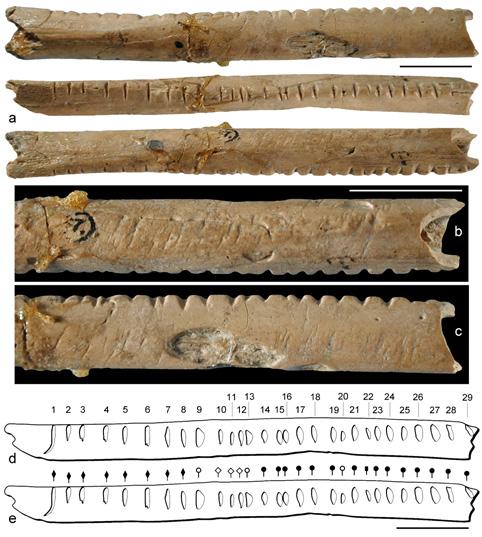
4 minute read
The evolution of cognitive tools for quantification (QUANTA
All humans – like many other animals – are able to perceive approximate quantities, but only humans can precisely count them. We are also the only species that uses symbols to express quantities (with words such as “one, two, three”), communicate them visually (for example with our fingers), or record them (by writing them down with digits). These verbal and nonverbal numeral systems are our cognitive tools for quantification, and we employ them to understand and transform the world. And yet, while we do have an entire scientific discipline to teach us what we can do with numbers, we know very little about their origin and evolution. When, why, and how did our ancestors develop these tools? Were those seeking shelter in Blombos Cave and Klipdrift a hundred thousand years ago (100 ka) already interested in exact quantities? And did they possess, or develop, such cognitive tools for counting? Questions like these lie at the heart of the QUANTA project, funded by a European Research Council (ERC) Synergy Grant.

A baboon fibula found at the famous site of Border Cave, South Africa, represents one of the earliest known devices for storing numerical information. Microscopic analysis of the 29 surviving notches identifies four, possibly five, groups, each made by a different tool. In two cases, new notches were added in between already carved notches. This observation – together with the heavily polished appearance of the bone surface from long-term handling and curation – indicate that the sets of notches were added at different times, suggesting a notational rather than a decorative purpose. As the layer in which the bone was found is dated to 44-42 ka, this device for storing numerical information predates the ones that were previously thought to be an innovation of the European Upper Palaeolithic. One exciting possibility to be explored is whether similar or different devices (or antecedents thereof) of an even greater age can be found in one of the SapienCE sites. [from d’Errico et al. (2018), Phil. Trans. R. Soc. (photo and drawings by F. d’Errico)]
Abstract reasoning and the active usage of symbols are considered hallmarks of cognitively and behaviourally modern humans; and dealing with numerical information is a paradigmatic instance of both. Some of the preconditions of numerical cognition, such as the ability to keep track of up to three items via subitizing (immediate, accurate judgement of small quantities) and to approximate larger quantities, are biologically evolved and shared with a range of non-human species. Exact quantification, however – that is the ability to accurately assess, remember, express, and convey discrete quantities beyond the subitizing range in an exact manner – is uniquely human. For this ability to unfold, both cognitive tools and conceptual breakthroughs are indispensable.
Presumably the most fundamental cognitive tool for exact quantification is a conventionalised sequence (such as “one, two, three, …”) that allows for counting. Lacking such a tool or being prevented from using it impairs people’s ability to count or recall exact quantities beyond the subitizing range. Each such sequence constitutes a numeral system, the properties of which depend on the number and shape of its elements, their order and relations, or the modality in which they are realised (e.g., as number words, body-based representations, or written notations). These properties may, in turn, affect the efficiency with which discrete quantities are represented and processed. Such counting sequences have been in use, to various degrees, in almost every speech community around the world for at least several millennia, and today exhibit striking diversity. However, their origins and the driving forces in their diversification have remained in the dark.
The conceptual breakthroughs needed for being able to count comprise the insight that numbers are systemic and refer to categorically discrete quantities: that, say, “five” indicates exactly five objects and not more or less, or that it is the same as three and two. Learning to count with number words - including comprehension of the numerical meaning of these words - requires realizing of several principles, such as that each number word has to be assigned to exactly one object, that number words occur in a fixed order, or that the number word for the last object represents the cardinality of the set.
Yet, inventing tools for quantification – even apparently simple ones such as number words – is a much more challenging task than it may seem. A whole series of developmental studies demonstrate that achieving the conceptual breakthroughs depends on the cognitive tool already being in place. That is, children can recite the basic number words long before they begin to grasp the numerical meaning of the words, the concept of numbers, or the principles involved in counting; and they appear to need guidance for achieving this understanding. This poses a tantalizing paradox: If the ability to count does indeed presuppose a counting sequence, how could such a tool ever be invented in the first place?
A MULTIDISCIPLINARY APPROACH
This question is surprisingly challenging to answer: not only because we know so little about counting practices in the past, but also because quantification is a multi-dimensional phenomenon at the intersection of several disciplines, ranging from anthropology, evolutionary biology, and archaeology to linguistics, psychology, and cognitive science. Integrating theoretical perspectives, conceptual models, data sets, and analytical methods across disciplines is therefore critical. Only a profoundly multidisciplinary approach will enable QUANTA to identify the earliest quantification tools in prehistory, to assess just how diverse such tools can be across space and time, and to understand when and why they emerge and change. For achieving these goals, QUANTA will harness a theoretical grid for analysing all types of quantification tools in a unified way, and powerful computational means to reconstruct how they evolved and diversified.








